Revisit the Medieval Warm Period and Little Ice Age in Proxy Records from Zemu Glacier Sediments, Eastern Himalaya: Vegetation and Climate Reconstruction
Abstract
1. Introduction
2. Materials and Methods
Study Sites, Environmental Setting and Vegetation
3. Results
3.1. Modern Pollen Sites and Assemblages
3.2. Ordination
3.3. Chronology and Palaeo–Vegetation History
3.4. Pollen–Climate Calibration and Transfer Function
3.5. Late Holocene Quantitative Palaeoclimate Reconstructions
3.6. Magnetic Parameters, Fossil Pollen and Quantitative Palaeoclimate
4. Discussion
4.1. Modern Pollen Distribution
4.2. Pollen–Climate Relationships
4.3. Environmental Geomagnetism and Climate Reconstruction
4.4. Evaluation of Climate Reconstructions
4.5. Climate Reconstructions Comparison
4.5.1. Climate Reconstructions Comparison—Qualitative Approach
4.5.2. Climate Reconstructions Comparison—Quantitative Approach

4.6. Climate Reconstructions and Fluctuation of Sikkimese Glaciers
5. Conclusions
Supplementary Materials
Author Contributions
Funding
Data Availability Statement
Acknowledgments
Conflicts of Interest
References
- Sarntheina, M.; Kennett, J.P.; Allen, J.R.M.; Beer, J.; Grootes, P.; Laj, C.; McManus, J.; Ramesh, R.; SCOR—IMAGES Working Group 117. Decadal–to–millennial–scale climate variability—Chronology and mechanisms: Summary and recommendations. Quat. Sci. Rev. 2002, 21, 1121–1128. [Google Scholar] [CrossRef]
- Bradley, R.S. Past global changes and their significance for the future. Quat. Sci. Rev. 2000, 19, 391–402. [Google Scholar] [CrossRef]
- Beniston, M. Climate Change in Mountain Regions: A Review of Possible Impacts. Clim. Chang. 2003, 59, 5–31. [Google Scholar] [CrossRef]
- Whiteman, D. Mountain Meteorology; Oxford University Press: New York, NY, USA, 2000; p. 355. [Google Scholar]
- Thompson, L.G. Ice core evidence for climate changes in the Tropics: Implications for our future. Quat. Sci. Rev. 2000, 19, 19–35. [Google Scholar] [CrossRef]
- Lowe, J.J.; Walker, M.J.C. Reconstructing Quaternary Environments, 2nd ed.; Longman Asia Limited: Hong Kong, China, 2015. [Google Scholar]
- Bradley, R.S. Paleoclimatology: Reconstructing Climates of the Quaternary, 3rd ed.; Elsevier/Academic Press: San Diego, CA, USA, 2014; p. 675. [Google Scholar]
- Lamb, H. The early medieval warm epoch and its sequel. Palaeogeogr. Palaeoclim. Palaeoecol. 1965, 1, 13–37. [Google Scholar] [CrossRef]
- Stine, S. Medieval climatic anomaly in the Americas. In Water, Environment and Society in Times of Climatic Change; Issar, A.S., Brown, N., Eds.; Kluwer: Dordrecht, The Netherlands, 1998; pp. 43–67. [Google Scholar]
- Mann, M.E.; Zhang, Z.; Rutherford, S.; Bradley, R.S.; Hughes, M.K.; Shindell, D.; Ammann, C.; Faluvegi, G.; Ni, F. Global signatures and dynamical origins of the little ice age and Wanner medieval climate anomaly. Science 2009, 326, 1256–1260. [Google Scholar] [CrossRef] [PubMed]
- Graham, N.E.; Ammann, C.M.; Fleitmann, D.; Cobb, K.M.; Luterbacher, J. Support for global climate reorganization during the “Medieval Climate Anomaly”. Clim. Dyn. 2010, 37, 1217–1245. [Google Scholar] [CrossRef]
- Grove, J.M. The Little Ice Age; Methuen: London, UK, 1988. [Google Scholar]
- Bhattacharyya, A.; Shah, S.K. Tree–ring study in India—Past appraisal, present status and future prospects. IAWA 2009, 30, 361–370. [Google Scholar] [CrossRef]
- Bhattacharyya, A.; Chaudhary, V. Late-Summer Temperature Reconstruction of the Eastern Himalayan Region Based on Tree-Ring Data of Abies densa. Arct. Antarct. Alp. Res. 2003, 35, 196–202. [Google Scholar] [CrossRef]
- Shah, S.K.; Mehrotra, N.; Bhattacharyya, A. Tree ring studies from Eastern Himalaya: Prospects and challenges. Him. Res. J. 2014, 2, 21–28. [Google Scholar]
- Krusic, P.J.; Cook, E.R.; Dukpa, D.; Putnam, A.E.; Rupper, S.; Schaefer, J. Six hundred thirty-eight years of summer temperature variability over the Bhutanese Himalaya. Geophys. Res. Lett. 2015, 42, 2988–2994. [Google Scholar] [CrossRef]
- Birks, H.J.B. The use of pollen analysis in the reconstruction of past climates: A review. In Climate and History; Wigley, T.M.L., Ingram, M.J., Farmer, G., Eds.; Cambridge University Press: Cambridge, UK, 1981; pp. 111–138. [Google Scholar]
- Huntley, B. Quaternary palaeoecology and ecology. Quat. Sci. Rev. 1996, 15, 591–606. [Google Scholar] [CrossRef]
- Birks, H.J.B. Numerical analysis methods. In Encyclopedia of Quaternary Science; Elias, S., Ed.; Elsevier: Amsterdam, The Netherlands, 2007; pp. 2514–2521. [Google Scholar]
- Brewer, S.; Guiot, J.; Barboni, D. Use of pollen as climate proxies. In Encyclopedia of Quaternary Science; Elias, S., Ed.; Elsevier: Amsterdam, The Netherlands, 2007; pp. 2497–2508. [Google Scholar]
- Edwards, M.E. BIOME model of vegetation reconstruction. In Encyclopedia of Quaternary Science; Elias, S., Ed.; Elsevier: Amsterdam, The Netherlands, 2007; pp. 2551–2561. [Google Scholar]
- Seppä, H. Pollen analysis, Principles. In Encyclopedia of Quaternary Science; Elias, S., Ed.; Elsevier: Amsterdam, The Netherlands, 2007; pp. 2486–2497. [Google Scholar]
- Bhattacharyya, A.; Ranhotra, P.S.; Shah, S.K. Temporal and spatial variations of late Pleistocene–Holocene climate of the western Himalaya based on pollen records and their implications to Monsoon dynamics. J. Geol. Soc. India 2006, 68, 507–515. [Google Scholar]
- Bhattacharyya, A.; Ranhotra, P.S.; Shah, S.K. Spatio Temporal Variation of Alpine Vegetation vis–à–vis Climate during Holocene in the Himalaya. Mem. Geol. Soc. India 2011, 77, 309–319. [Google Scholar]
- Mehrotra, N.; Shah, S.K.; Bhattacharyya, A. Review of palaeoclimate records from Northeast India based on pollen proxy data of Late Pleistocene–Holocene. Quat. Int. 2014, 325, 41–54. [Google Scholar] [CrossRef]
- Seppä, H.; Bennett, K.D. Quaternary pollen analysis: Recent progress in palaeoecology and palaeoclimatology. Prog. Phys. Geogr. 2003, 27, 548–579. [Google Scholar] [CrossRef]
- Iversen, J. Viscum, Hedera and Ilex as climatic indicators. A contribution to the study of the post–glacial temperature climate. Geol. Föreningens I Stockh. Förhandlingar 1944, 66, 463–483. [Google Scholar] [CrossRef]
- Grichuk, V.P. An experiment in reconstructing some characteristics of climate in the Northern Hemisphere during the Atlantic Period of Holocene. In Holocene; Neustadt, M.I., Ed.; Nauka: Moscow, Russia, 1969; pp. 41–57. [Google Scholar]
- Tarasov, P.E.; Nakagawa, T.; Demske, D.; Österle, H.; Igarashi, Y.; Kitagawa, J.; Mokhova, L.; Bazarova, V.; Okuda, M.; Gotanda, K.; et al. Progress in the reconstruction of Quaternary climate dynamics in the Northwest Pacific: A new modern analogue reference dataset and its application to the 430-kyr pollen record from Lake Biwa. Earth Sci. Rev. 2011, 108, 64–79. [Google Scholar] [CrossRef]
- Imbrie, J.; Kipp, N.G. A new micropaleontological method for quantitative paleoclimatology: Application to a late Pleistocene Caribbean core. In The Late Cenozoic Glacial Ages; Turekian, K.K., Ed.; Yale University Press: New Haven, CT, USA, 1971; pp. 71–181. [Google Scholar]
- Webb, I.I.I.T.; Thompson, B.; Bryson, R.A. Late-and postglacical climatic change in the northern Midwest, USA: Quantitative estimates from fossil pollen spectra by multivariate statistical analysis. Quat. Res. 1972, 2, 70–115. [Google Scholar] [CrossRef]
- Bartlein, P.J.; Webb, T.I.I.I.; Fleri, E. Holocene climatic change in the northern Midwest: Pollen–derived estimates. Quat. Res. 1984, 22, 361–374. [Google Scholar] [CrossRef]
- Bartlein, P.J.; Webb, T.I.I.I. Mean July temperature at 6000 yr B.P. in eastern North America: Regression equations for estimates from fossil–pollen data. Syllogeus 1985, 55, 301–342. [Google Scholar]
- Guiot, J. Late Quaternary Climatic Change in France Estimated from Multivariate Pollen Time Series. Quat. Res. 1987, 28, 100–118. [Google Scholar] [CrossRef]
- Huntley, B.; Prentice, I.C. July temperature in Europe from pollen data, 6000 years before present. Science 1988, 241, 687–690. [Google Scholar] [CrossRef]
- Guiot, J.; Pons, A.; de Beaulieu, J.-L.; Reille, M. A 140,000–year climatic reconstruction from two European pollen records. Nature 1989, 338, 309–313. [Google Scholar] [CrossRef]
- ter Braak, C.J.F.; Juggins, S. Weighted averaging partial least squares regression (WA–PLS): An improved method for reconstruction environmental variables from species assemblages. Hydrobiologia 1993, 269, 485–502. [Google Scholar] [CrossRef]
- Birks, H.J.B. Quantitative palaeoenvironmental reconstructions. In Statistical Modelling of Quaternary Science Data; Maddy, D., Brew, J.S., Eds.; Quaternary Research Association: Cambridge, UK, 1995; pp. 161–254. [Google Scholar]
- Peyron, O.; Guiot, J.; Cheddadi, R.; Tarasov, P.E.; Reille, M.; deBeaulieu, J.-L.; Bottema, S.; Andrieu, V. Climatic reconstruction in Europe from pollen data, 18,000 years before present. Quat. Res. 1998, 49, 183–196. [Google Scholar] [CrossRef]
- Seppä, H.; Birks, H.J.B. July mean temperature and annual precipitation trends during the Holocene in the Fennoscandian tree–line area, pollen–based reconstructions. Holocene 2001, 11, 527–539. [Google Scholar] [CrossRef]
- Seppä, H.; Birks, H. Holocene Climate Reconstructions from the Fennoscandian Tree-Line Area Based on Pollen Data from Toskaljavri. Quat. Res. 2002, 57, 191–199. [Google Scholar] [CrossRef]
- Markgraf, V.; Webb, R.S.; Anderson, K.H.; Anderson, L. Modern pollen/climate calibration for southern South America. Palaeogeogr. Palaeoclimatol. Palaeoecol. 2002, 181, 375–397. [Google Scholar] [CrossRef]
- Davis, B.; Brewer, S.; Stevenson, A.; Guiot, J. The temperature of Europe during the Holocene reconstructed from pollen data. Quat. Sci. Rev. 2003, 22, 1701–1716. [Google Scholar] [CrossRef]
- Seppä, H.; Birks, H.J.B.; Odland, A.; Poska, A.; Veski, S. A modern pollen-climate calibration set from northern Europe: Developing and testing a tool for palaeoclimatological reconstructions. J. Biogeogr. 2004, 31, 251–267. [Google Scholar] [CrossRef]
- Seppä, H.; Hammarlund, D.; Antonsson, K. Low–frequency and high frequency changes in temperature and effective humidity during the Holocene in south–central Sweden, implications for atmospheric and oceanic forcings of climate. Clim. Dyn. 2005, 25, 285–297. [Google Scholar] [CrossRef]
- Seppä, H.; MacDonald, G.M.; Birks, H.J.B.; Gervais, B.R.; Snyder, J.A. Late-Quaternary summer temperature changes in the northern-European tree-line region. Quat. Res. 2008, 69, 404–412. [Google Scholar] [CrossRef]
- Seppä, H.; Bjune, A.E.; Telford, R.J.; Birks, H.J.B.; Veski, S. Last nine-thousand years of temperature variability in Northern Europe. Clim. Past 2009, 5, 523–535. [Google Scholar] [CrossRef]
- Tarasov, P.; Granoszewski, W.; Bezrukova, E.; Brewer, S.; Nita, M.; Abzaeva, A.; Oberhänsli, H. Quantitative reconstruction of the last interglacial vegetation and climate based on the pollen record from Lake Baikal, Russia. Clim. Dyn. 2005, 25, 625–637. [Google Scholar] [CrossRef]
- Tarasov, P.E.; Bezrukova, E.V.; Krivonogov, S.K. Late glacial and Holocene changes in vegetation cover and climate in southern Siberia derived from a 15 kyr long pollen record from Lake Kotokel. Clim. Past. 2009, 5, 73–84. [Google Scholar] [CrossRef]
- Peros, M.C.; Gajewski, K. Holocene climate and vegetation change on Victoria Island, western Canadian Arctic. Quat. Sci. Rev. 2008, 27, 235–249. [Google Scholar] [CrossRef]
- Dormoy, I.; Peyron, O.; Nebout, N.C.; Goring, S.; Kotthoff, U.; Magny, M.; Pross, J. Terrestrial climate variability and seasonality changes in the Mediterranean region between 15 000 and 4000 years BP deduced from marine pollen records. Clim. Past 2009, 5, 615–632. [Google Scholar] [CrossRef]
- Litt, T.; Schölzel, C.; Kühl, N.; Brauer, A. Vegetation and climate history in the Westeifel Volcanic Field (Germany) during the past 11 000 years based on annually laminated lacustrine maar sediments. Boreas 2009, 38, 679–690. [Google Scholar] [CrossRef]
- Bartlein, P.J.; Harrison, S.; Brewer, S.; Connor, S.; Davis, B.A.S.; Gajewski, K.; Guiot, J.; Harrison-Prentice, T.I.; Henderson, A.P.; Peyron, O.; et al. Pollen-based continental climate reconstructions at 6 and 21 ka: A global synthesis. Clim. Dyn. 2011, 37, 775–802. [Google Scholar] [CrossRef]
- Nakagawa, T.; Tarasov, P.E.; Nishida, K.; Gotanda, K.; Yasuda, Y. Quantitative pollen-based climate reconstruction in central Japan: Application to surface and Late Quaternary spectra. Quat. Sci. Rev. 2002, 21, 2099–2113. [Google Scholar] [CrossRef]
- Nakagawa, T.; Kitagawa, H.; Yasuda, Y.; Tarasov, P.E.; Kotoba, N.; Gotanda, K.; Sawai, Y.; Program, Yangtze River Civilization. Asynchronous Climate Changes in the North Atlantic and Japan During the Last Termination. Science 2003, 299, 688–691. [Google Scholar] [CrossRef] [PubMed]
- Jiang, W.; Guo, Z.; Sun, X.; Wu, H.; Chu, G.; Yuan, B.; Hatté, C.; Guiot, J. Reconstruction of climate and vegetation changes of Lake Bayanchagan (Inner Mongolia): Holocene variability of the East Asian monsoon. Quat. Res. 2006, 65, 411–420. [Google Scholar] [CrossRef]
- Shen, C.; Liu, K.-B.; Tang, L.; Overpeck, J.T. Quantitative relationships between modern pollen rain and climate in the Tibetan Plateau. Rev. Palaeobot. Palynol. 2006, 140, 61–77. [Google Scholar] [CrossRef]
- Tarasov, P.; Jin, G.; Wagner, M. Mid-Holocene environmental and human dynamics in northeastern China reconstructed from pollen and archaeological data. Palaeogeogr. Palaeoclim. Palaeoecol. 2006, 241, 284–300. [Google Scholar] [CrossRef]
- Li, Y.; Xu, Q.; Liu, J.; Yang, X.; Nakagawa, T. A transfer-function model developed from an extensive surface-pollen data set in northern China and its potential for palaeoclimate reconstructions. Holocene 2007, 17, 897–905. [Google Scholar] [CrossRef]
- Zhu, C.; Chen, X.; Zhang, G.S.; Ma, C.M.; Zhu, Q.; Li, Z.X.; Xu, W.F. Spore pollen–climate factor transfer function and paleoenvironment reconstruction in Dajiuhu, Shennongjia, Central China. Chin. Sci. Bull. 2008, 53, 42–49. [Google Scholar] [CrossRef]
- Herzschuh, U.; Kramer, A.; Mischke, S.; Zhang, C. Quantitative climate and vegetation trends since the late glacial on the northeastern Tibetan Plateau deduced from Koucha Lake pollen record. Quat. Res. 2009, 71, 162–171. [Google Scholar] [CrossRef]
- Herzschuh, U.; Birks, H.J.B.; Mischke, S.; Zhang, C.; Böhner, J. A modern pollen-climate calibration set based on lake sediments from the Tibetan Plateau and its application to a Late Quaternary pollen record from the Qilian Mountains. J. Biogeogr. 2010, 37, 752–766. [Google Scholar] [CrossRef]
- Xu, Q.; Xiao, J.; Li, Y.; Tian, F.; Nakagawa, T. Pollen–Based Quantitative Reconstruction of Holocene Climate Changes in the Daihai Lake Area, Inner Mongolia, China. J. Clim. 2010, 23, 2856–2867. [Google Scholar] [CrossRef]
- Park, J. A modern pollen–temperature calibration data set from Korea and quantitative temperature reconstructions for the Holocene. Holocene 2011, 21, 1125–1135. [Google Scholar] [CrossRef]
- Sun, A.; Feng, Z. Holocene climatic reconstructions from the fossil pollen record at Qigai Nuur in the southern Mongolian Plateau. Holocene 2013, 23, 1391–1402. [Google Scholar] [CrossRef]
- Wen, R.; Xiao, J.; Ma, Y.; Feng, Z.; Li, Y.; Xu, Q. Pollen–climate transfer functions intended for temperate eastern Asia. Quat. Int. 2013, 311, 3–11. [Google Scholar] [CrossRef]
- Birks, H.J.B. Numerical tools in palaeolimnology—Progress, potentialities, and problems. J. Paleolimnol. 1998, 20, 307–332. [Google Scholar] [CrossRef]
- Birks, H.J.B.; Seppä, H. Pollen–based reconstructionsof late–Quaternary climate in Europe—Progress, problems, and pitfalls. Acta Palaeobot. 2004, 44, 317–334. [Google Scholar]
- Kumke, T.; Schölzel, C.; Hense, A. Transfer functions for palaeoclimate reconstructions—Theory and methods. In The Climate in Historical Times; Fischer, H., Kumke, T., Lohmann, G., Flöser, G., Miller, H., von Storch, H., Negendank, J.F.W., Eds.; Springer: Berlin, Germany, 2004; pp. 229–243. [Google Scholar]
- John, H.; Birks, B. Quantitative palaeoenvironmental reconstructions from Holocene Biological data. In Global Change in the Holocene; Mackay, A., Rick, B., Birks, J., Oldfield, F., Eds.; Arnold: London, UK, 2005; p. 528. [Google Scholar]
- Telford, R.; Birks, H. The secret assumption of transfer functions: Problems with spatial autocorrelation in evaluating model performance. Quat. Sci. Rev. 2005, 24, 2173–2179. [Google Scholar] [CrossRef]
- Guiot, J.; de Vernal, A. Transfer functions: Methods for quantitative paleoceanography based on microfossils. In Developments in Marine Geology 1—Proxies in Late Cenozoic Paleoceanography; Hillaire Marcel, C., de Vernal, A., Eds.; Elsevier: Amsterdam, Netherlands, 2007; pp. 523–563. [Google Scholar]
- Guiot, J. Transfer Functions. IOP Conf. Ser. Earth Environ. Sci. 2011, 14, 1–6. [Google Scholar] [CrossRef]
- Juggins, S.; Birks, H.J.B. Quantitative environmental reconstructions from biostratigraphical data. In Tracking Environmental Change Using Lake Sediments Data Handling and Numerical Techniques; Birks, H.J.B., Lotter, A.F., Juggins, S., Smol, J.P., Eds.; Springer: Dordrecht, The Netherlands, 2011; Volume 5. [Google Scholar]
- Lu, H.; Wu, N.; Liu, K.-B.; Zhu, L.; Yang, X.; Yao, T.; Wang, L.; Li, Q.; Liu, X.; Shen, C.; et al. Modern pollen distributions in Qinghai–Tibetan Plateau and the development of transfer functions for reconstructing Holocene environmental changes. Quat. Sci. Rev. 2011, 30, 947–966. [Google Scholar] [CrossRef]
- Ohlwein, C.; Wahl, E.R. Review of probabilistic pollen-climate transfer methods. Quat. Sci. Rev. 2012, 31, 17–29. [Google Scholar] [CrossRef]
- Birks, H.J.B. Numerical methods for the analysis of diatom assemblage data. In The Diatoms—Applications for the Environmental and Earth Sciences; Smol, J.P., Stoermer, E.F., Eds.; Cambridge University Press: Cambridge, UK, 2010; pp. 23–54. [Google Scholar]
- Ghosh, R.; Paruya, D.K.; Khan, M.A.; Chakraborty, S.; Sarkar, A.; Bera, S. Late Quaternary climate variability and vegetation response in Ziro Lake Basin, Eastern Himalaya: A multiproxy approach. Quat. Int. 2014, 325, 13–29. [Google Scholar] [CrossRef]
- Ghosh, R.; Bera, S.; Sarkar, A.; Paruya, D.K.; Yao, Y.F.; Li, C.S. ~50 ka record of monsoonal variability in the Darjeeling foothill region, eastern Himalayas. Quat. Sci. Rev. 2015, 114, 100–115. [Google Scholar] [CrossRef]
- Mosbrugger, V.; Utescher, T. The coexistence approach—A method for quantitative reconstructions of Tertiary terrestrial palaeoclimate data using plant fossils. Palaeogeogr. Palaeoclim. Palaeoecol. 1997, 134, 61–86. [Google Scholar] [CrossRef]
- Utescher, T.; Bruch, A.; Erdei, B.; François, L.; Ivanov, D.; Jacques, F.; Kern, A.; Liu, Y.-S.; Mosbrugger, V.; Spicer, R. The Coexistence Approach—Theoretical background and practical considerations of using plant fossils for climate quantification. Palaeogeogr. Palaeoclim. Palaeoecol. 2014, 410, 58–73. [Google Scholar] [CrossRef]
- Sun, N.; Li, X.Q. The quantitative reconstruction of the palaeoclimate between 5200 and 4300 cal yr BP in the Tianshui Basin, NW China. Clim. Past 2012, 8, 625–636. [Google Scholar] [CrossRef]
- Tang, Y.-N.; Li, X.; Yao, Y.-F.; Ferguson, D.K.; Li, C.-S. Environmental Reconstruction of Tuyoq in the Fifth Century and Its Bearing on Buddhism in Turpan, Xinjiang, China. PLoS ONE 2014, 9, e86363. [Google Scholar] [CrossRef] [PubMed]
- Sharma, C.; Chauhan, M.S. Palaeoclimatic inferences from quaternary palynostratigraphy of the Himalayas. In The Himalayan Environment; Dash, S.K., Bahadur, J., Eds.; New Age International: New Delhi, India, 1999; pp. 193–207. [Google Scholar]
- Sharma, C.; Chauhan, M.S. Late Holocene vegetation climate Kupup Sikkim, eastern Himalaya, India. J. Palaeontol. Soc. India 2001, 46, 51–58. [Google Scholar]
- Sharma, C.; Chauhan, M.S. Vegetation and climate since Last Glacial Maxima in Darjeeling (Mirik Lake), Eastern Himalaya. In Proceedings of the 29th International Geological Congress, Kyoto, Japan, 24 August–3 September 1992; pp. 279–288. [Google Scholar]
- Chauhan, M.S.; Sharma, C. Late Holovene vegetation of Darjeeling (Jore-Pokhari) eastern Himalaya. Palaeobotanist 1996, 45, 125–129. [Google Scholar]
- Dubey, J.; Ghosh, R.; Agrawal, S.; Quamar, M.; Morthekai, P.; Sharma, R.; Sharma, A.; Pandey, P.; Srivastava, V.; Ali, S.N. Characteristics of modern biotic data and their relationship to vegetation of the Alpine zone of Chopta valley, North Sikkim, India: Implications for palaeovegetation reconstruction. Holocene 2018, 28, 363–376. [Google Scholar] [CrossRef]
- Thompson, R.; Oldfield, F. Environmental Magnetism; Allen and Unwin Press: London, UK, 1986. [Google Scholar]
- Basavaiah, N.; Khadkikar, A.S. Environmental magnetism and paleomonsoon. J. Indian Geophys. Union 2004, 8, 1–77. [Google Scholar]
- Basavaiah, N. Geomagnetism: Solid Earth and Upper Atmosphere Perspectives; Springer: Dordrecht, The Netherlands, 2011; pp. 291–386. [Google Scholar]
- Basavaiah, N.; Seetharamaiah, J.; Appel, E.; Juyal, N.; Prasad, S.; Nageswara Rao, K.; Khadkikar, A.S.; Nowaczyk, N.; Brauer, A. Holocene environmental magnetic records of Indian monsoon fluctuations. In Holocene Climate Change and Environment; Kumaran, N., Damodara, P., Eds.; Elsevier: Amsterdam, Netherlands, 2022; pp. 229–247. [Google Scholar] [CrossRef]
- Sukumaran, P.; Sant, D.A.; Krishnan, K.; Rangarajan, G.; Basavaiah, N.; Schwenninger, J.-L. Multi-Proxy Records of Late Holocene Flood Events From the Lower Reaches of the Narmada River, Western India. Front. Earth Sci. 2021, 9, 634354. [Google Scholar] [CrossRef]
- Maher, B. The magnetic properties of Quaternary aeolian dusts and sediments, and their palaeoclimatic significance. Aeolian Res. 2011, 3, 87–144. [Google Scholar] [CrossRef]
- Liu, Q.; Roberts, A.P.; Larrasoaña, J.C.; Banerjee, S.K.; Guyodo, Y.; Tauxe, L.; Oldfield, F. Environmental magnetism: Principles and applications. Rev. Geophys. 2012, 50, RG4002. [Google Scholar] [CrossRef]
- Maxbauer, D.P.; Feinberg, J.M.; Fox, D.L. Magnetic mineral assemblages in soils and paleosols as the basis for paleoprecipitation proxies: A review of magnetic methods and challenges. Earth Sci. Rev. 2016, 155, 28–48. [Google Scholar] [CrossRef]
- Basavaiah, N.; Juyal, N.; Pant, R.K.; Yadava, M.G.; Singhvi, A.K.; Appel, E. Late Quaternary climate changes reconstructed from mineral magnetic studies from proglacial lake deposits of Higher Central Himalaya. J. Indian Geophys.Union 2004, 8, 27–38. [Google Scholar]
- Juyal, N.; Pant, R.K.; Basavaiah, N.; Yadava, M.G.; Saini, N.K.; Singhvi, A.K. Climate and seismicity in the Higher Central Himalaya during the last 20 ka: Evidences from Garbyang basin, Uttaranchal. Palaeogeogr. Palaeoclimatol. Palaeoecol. 2004, 213, 315–330. [Google Scholar] [CrossRef]
- Juyal, N.; Pant, R.; Basavaiah, N.; Bhushan, R.; Jain, M.; Saini, N.; Yadava, M.; Singhvi, A. Reconstruction of Last Glacial to early Holocene monsoon variability from relict lake sediments of the Higher Central Himalaya, Uttrakhand, India. J. Asian Earth Sci. 2009, 34, 437–449. [Google Scholar] [CrossRef]
- Bhattacharyya, A.; Mehrotra, N.; Shah, S.K.; Basavaiah, N.; Chaudhary, V.; Singh, I.B. Analysis of vegetation and climate change during Late Pleistocene from Ziro Valley, Arunachal Pradesh, Eastern Himalaya region. Quat. Sci. Rev. 2014, 101, 111–123. [Google Scholar] [CrossRef]
- Mehrotra, N.; Shah, S.K.; Basavaiah, N.; Laskar, A.H.; Yadava, M.G. Resonance of the ‘4.2ka event’ and terminations of global civilizations during the Holocene, in the palaeoclimate records around PT Tso Lake, Eastern Himalaya. Quat. Int. 2019, 507, 206–216. [Google Scholar] [CrossRef]
- Basavaiah, N.; Appel, E.; Lakshmi, B.V.; Deenadayalan, K.; Satyanarayana, K.V.V.; Misra, S.; Juyal, N.; Malik, M.A. Revised magnetostratigraphy and characteristics of the fluviolacustrine sedimentation of the Kashmir basin, India, during Pliocene-Pleistocene. J. Geophys. Res. Solid Earth 2010, 115, B8. [Google Scholar] [CrossRef]
- Basavaiah, N.; Babu, J.M.; Gawali, P.; Kumar, K.N.; Demudu, G.; Prizomwala, S.P.; Hanamgond, P.; Rao, K.N. Late Quaternary environmental and sea level changes from Kolleru Lake, SE India: Inferences from mineral magnetic, geochemical and textural analyses. Quat. Int. 2015, 371, 197–208. [Google Scholar] [CrossRef]
- G.S.I. Geological and Mineral Resources of Sikkim, Geological Survey of India Miscellaneous Publication No. 30, Part XIX—Sikkim; Government of India: New Delhi, India, 2012. [Google Scholar]
- Kaul, M.K. Inventory of the Himalayan Glaciers; Special Publication No. 34; Geological Survey of India, India: Kolkata, India, 1999; 165p. [Google Scholar]
- Bose, R.N.; Dutta, N.P.; Lahiri, S.M. Refraction seismic investigation at Zemu glacier, Sikkim. J. Glaciol. 1971, 10, 113–119. [Google Scholar] [CrossRef]
- LaTouche, T.H.D. Notes on certain glaciers in Sikkim. Rec. Geol. Surv. India 1910, 40, 52–62. [Google Scholar]
- Dutt, G.N. Geological Record of the Rangit Valley Expedition, Sikkim; Unpub. Report, GSI (F.S. 1954-55); 1955. [Google Scholar]
- Zhao, L.; Ping, C.-L.; Yang, D.; Cheng, G.; Ding, Y.; Liu, S. Changes of climate and seasonally frozen ground over the past 30 years in Qinghai–Xizang (Tibetan) Plateau, China. Glob. Planet. Chang. 2004, 43, 19–31. [Google Scholar] [CrossRef]
- Cheng, G.; Wu, T. Responses of permafrost to climate change and their environmental significant, Qinghai-Tibet Plateau. J. Geophys. Res. 2007, 112, F02S03. [Google Scholar]
- Samui, R.P. Rainfall variations along the teesta valley in mountainous slope of sikkim. Mausam 1994, 45, 165–170. [Google Scholar] [CrossRef]
- Srivastava, R.C. Introduction. In Flora of Sikkim; Hajra, P.K., Verma, D.M., Eds.; Botanical Survey of India, Government of India: New Delhi, India, 1996; pp. 1–22. [Google Scholar]
- Smith, W.W.; Cave, G.H. The vegetation of the Zemu and Llonakh valleys of Sikkim. Rec. Bot. Surv. India 1911, 4, 141–260. [Google Scholar]
- Erdtman, G. An Introduction to Pollen Analysis; Read Books Ltd.: Waltham, MA, USA, 1943; 239p. [Google Scholar]
- Grimm, E.C. TILIA and TG View 2.0.2, Springfield IL; Illinois State Museum: Springfield, IL, USA, 2004. [Google Scholar]
- Grimm, E.C. CONISS: A FORTRAN 77 program for stratigraphically constrained cluster analysis by the method of incremental sum of squares. Comput. Geosci. 1987, 13, 13–35. [Google Scholar] [CrossRef]
- Ramsey, C.B. Radiocarbon Calibration and Analysis of Stratigraphy: The OxCal Program. Radiocarbon 1995, 37, 425–430. [Google Scholar] [CrossRef]
- Seetharam, K. Climate change scenario over Gangtok. Letters to the editor. Meteorological center, Gangtok, Indian Me-teorological Department, India. Mausam 2008, 59, 361–366. [Google Scholar] [CrossRef]
- New, M.; Lister, D.; Hulme, M.; Makin, I. A high-resolution data set of surface climate over global land areas. Clim. Res. 2002, 21, 1–25. [Google Scholar] [CrossRef]
- Guiot, J.; Goeury, C. PPPBase, a software for statistical analysis of paleoecological and paleoclimatological data. Dendrochronologia 1996, 14, 295–300. [Google Scholar]
- Birks, H.J.B. Overview of Numerical Methods in Palaeolimnology. In Tracking Environmental Change Using Lake Sediments. Developments in Paleoenvironmental Research; Birks, H., Lotter, A., Juggins, S., Smol, J., Eds.; Springer: Dordrecht, The Netherlands, 2012; Volume 5. [Google Scholar] [CrossRef]
- Prentice, I. Multidimensional scaling as a research tool in quaternary palynology: A review of theory and methods. Rev. Palaeobot. Palynol. 1980, 31, 71–104. [Google Scholar] [CrossRef]
- ter Braak, C.J.F.; Šmilauer, P. CANOCO Reference Manual and User’s Guide: Software for Ordination, Version 5.0; Microcomputer Power: Ithaca, NY, USA, 2012; p. 496. [Google Scholar]
- ter Braak, C.J.F.; Prentice, I.C. A theory of gradient analysis. Adv. Ecol. Res. 1988, 18, 271–317. [Google Scholar]
- Lu, H.Y.; Wu, N.Q.; Yang, X.D.; Jiang, H.; Liu, K.-B.; Liu, T.S. Phytoliths as quantitative indicators for the reconstruction of past environmental conditions in China I: Phytolith–based transfer functions. Quat. Sci. Rev. 2006, 25, 945–959. [Google Scholar] [CrossRef]
- ter Braak, C.J.F. Ordination. In Data Analysis in Community and Landscape Ecology; Jongman, R.H., Ter Braak, C.J.F., van Tongeren, O.F.R., Eds.; Pudoc: Wageningen, The Netherlands, 1987; pp. 91–173. [Google Scholar]
- ter Braak, C.J.F.; Juggins, S.; Birks, H.J.B.; van der Voet, H. Weighted averaging partial least squares regression (WA-PLS): Definition and comparison with other methods for species-environment calibration. In Multivariate Environmental Statistics; Patil, G.P., Rao, C.R., Eds.; Elsevier Science Publishers, B.V.: Amsterdam; The Netherlands, 1993; Chapter 25; pp. 525–560. [Google Scholar]
- Wold, S.; Esbensen, K.; Geladi, P. Principal Component Analysis. Chemom. Intell. Lab. Syst. 1987, 2, 37–52. [Google Scholar] [CrossRef]
- Michaelsen, J. Cross-Validation in Statistical Climate Forecast Models. J. Clim. Appl. Meteorol. 1987, 26, 1589–1600. [Google Scholar] [CrossRef]
- R Core Team. R: A Language and Environment for Statistical Computing. R Foundation for Statistical Computing, Vienna, Austria. 2015. Available online: http://www.R–project.org/ (accessed on 28 August 2021).
- Juggins, S. Rioja: Analysis of Quaternary Science Data, R Package Version (0.8 7). 2012. Available online: http://cran.r–project.org/package=rioja (accessed on 28 August 2021).
- Beniston, M. Environmental Changes in Mountains and Uplands; Arnold Publisher, London and Oxford University Press: New York, NY, USA, 2000; p. 172. [Google Scholar]
- Rohli, R.V.; Vega, A.J. Climatology, Climatology, 2nd ed.; Jones and Bartlett Learning: Sudbury, MA, USA, 2012; p. 443. [Google Scholar]
- Wei, H.-C.; Ma, H.-Z.; Zheng, Z.; Pan, A.-D.; Huang, K.-Y. Modern pollen assemblages of surface samples and their relationships to vegetation and climate in the northeastern Qinghai-Tibetan Plateau, China. Rev. Palaeobot. Palynol. 2011, 163, 237–246. [Google Scholar] [CrossRef]
- Xiao, X.; Shen, J.; Wang, S. Spatial variation of modern pollen from surface lake sediments in Yunnan and southwestern Sichuan Province, China. Rev. Palaeobot. Palynol. 2011, 165, 224–234. [Google Scholar] [CrossRef]
- Luo, C.X.; Zheng, Z.; Tarasov, P.; Nakagawa, T.; Pan, A.D.; Xu, Q.H.; Lu, H.Y.; Huang, K.Y. A potential of pollen–based climate reconstruction using a modern polleneclimate dataset from arid northern and western China. Rev. Palaeobot. Palynol. 2010, 160, 111–125. [Google Scholar] [CrossRef]
- Cao, X.-Y.; Herzschuh, U.; Telford, R.J.; Ni, J. A modern pollen–climate dataset from China and Mongolia: Assessing its potential for climate reconstruction. Rev. Palaeobot. Palynol. 2014, 211, 87–96. [Google Scholar] [CrossRef]
- Maher, B.A.; Thompson, R. Mineral magnetic record of the Chinese loess and paleosols. Geology 1991, 19, 3–6. [Google Scholar] [CrossRef]
- Geiss, C.E.; Egli, R.; Zanner, C.W. Direct estimates of pedogenicmagnetite as a tool to reconstruct past climates from buried soils. J. Geophys. Res. 2008, 113, B11102. [Google Scholar] [CrossRef]
- Balsam, W.L.; Ellwood, B.B.; Ji, J.; Williams, E.R.; Long, X.; El Hassani, A. Magnetic susceptibility as a proxy for rainfall: Worldwide data from tropical and temperate climate. Quat. Sci. Rev. 2011, 30, 2732–2744. [Google Scholar] [CrossRef]
- Orgeira, M.J.; Egli, R.; Compagnucci, R.H. A quantitativemodel of magnetic enhancement in loessic soils. In The Earth’s Magnetic Interior; Petrovský, E., Ivers, D., Harinarayana, T., Herrero-Bervera, E., Eds.; Springer: Dordrecht, The Netherlands, 2011; pp. 361–397. [Google Scholar]
- Hyland, E.G.; Badgley, C.; Abrajevitch, A.; Sheldon, N.D.; Van Der Voo, R. A new paleoprecipitation proxy based on soil magnetic properties: Implications for expanding paleoclimate reconstructions. GSA Bulletin 2015, 127, 975–981. [Google Scholar] [CrossRef]
- Long, X.; Ji, J.; Balsam, W. Rainfall-dependent transformations of iron oxides in a tropical saprolite transect of Hainan Island, South China: Spectral and magnetic measurements. J. Geophys. Res. Earth Surf. 2011, 116, F3. [Google Scholar] [CrossRef]
- Porter, S.C.; Hallet, B.; Wu, X.; An, Z. Dependence of Near-Surface Magnetic Susceptibility on Dust Accumulation Rate and Precipitation on the Chinese Loess Plateau. Quat. Res. 2001, 55, 271–283. [Google Scholar] [CrossRef]
- Ma, M.; Liu, X.; Pillans, B.J.; Hu, S.; Lü, B.; Liu, H. Magnetic properties of Dashing Rocks loess at Timaru, South Island, New Zealand. Geophys. J. Int. 2013, 195, 75–85. [Google Scholar] [CrossRef]
- Begét, J.E.; Stone, D.B.; Hawkins, D.B. Paleoclimatic forcing of magnetic susceptibility variations in Alaskan loess during the late Quaternary. Geology 1990, 18, 40–43. [Google Scholar] [CrossRef]
- Geiss, C.E.; Zanner, C.W.; Banerjee, S.K.; Joanna, M. Signature of magnetic enhancement in a loessic soil in Nebraska, United States of America. Earth Planet. Sci. Lett. 2004, 228, 355–367. [Google Scholar] [CrossRef]
- Geiss, C.E.; Zanner, C.W. How abundant is pedogenic magnetite? Abundance and grain size estimates for loessic soils based on rock magnetic analyses. J. Geophys. Res. Solid Earth 2006, 111, B12. [Google Scholar] [CrossRef]
- Geiss, C.E.; Zanner, C.W. Sediment magnetic signature of climate in modern loessic soils from the Great Plains. Quat. Int. 2007, 162–163, 97–110. [Google Scholar] [CrossRef]
- Maher, B.; Alekseev, A.; Alekseeva, T. Variation of soil magnetism across the Russian steppe: Its significance for use of soil magnetism as a palaeorainfall proxy. Quat. Sci. Rev. 2002, 21, 1571–1576. [Google Scholar] [CrossRef]
- Maher, B.A.; Alekseev, A.; Alekseeva, T. Magnetic mineralogy of soils across the Russian Steppe: Climatic dependence of pedogenicmagnetite formation. Palaeogeogr. Palaeoclimatol. Palaeoecol. 2003, 201, 321–341. [Google Scholar] [CrossRef]
- Maher, B.; Thompson, R. Paleoclimatic Significance of the Mineral Magnetic Record of the Chinese Loess and Paleosols. Quat. Res. 1992, 37, 155–170. [Google Scholar] [CrossRef]
- Kukla, G.; Heller, F.; Ming, L.X.; Chun, X.T.; Sheng, L.T.; Sheng, A.Z. Pleistocene climates in China dated by magnetic susceptibility. Geology 1988, 16, 811–814. [Google Scholar] [CrossRef]
- Liu, Q.; Deng, C.; Torrent, J.; Zhu, R. Review of recent developments in mineral magnetism of the Chinese loess. Quat. Sci. Rev. 2007, 26, 368–385. [Google Scholar] [CrossRef]
- Heslop, D.; Roberts, A.P. Calculating uncertainties on predictions of palaeoprecipitation from the magnetic properties of soils. Glob. Planet. Chang. 2013, 110, 379–385. [Google Scholar] [CrossRef]
- Maher, B.; Possolo, A. Statistical models for use of palaeosol magnetic properties as proxies of palaeorainfall. Glob. Planet. Chang. 2013, 111, 280–287. [Google Scholar] [CrossRef]
- Polanski, S.; Fallah, B.; Befort, D.J.; Prasad, S.; Cubasch, U. Regional moisture change over India during the past Millennium: A comparison of multi-proxy reconstructions and climate model simulations. Glob. Planet. Chang. 2014, 122, 176–185. [Google Scholar] [CrossRef]
- Jiang, Y.; Xu, Z. On the Spörer minimum. Astrophy. Space Sci. 1985, 118, 159–162. [Google Scholar] [CrossRef]
- Eddy, J.A. The Maunder Minimum. Science 1976, 192, 1189–1202. [Google Scholar] [CrossRef] [PubMed]
- Shindell, D.T.; Schmidt, G.A.; Mann, M.E.; Rind, D.; Waple, A. Solar Forcing of Regional Climate Change During the Maunder Minimum. Science 2001, 294, 2149–2152. [Google Scholar] [CrossRef] [PubMed]
- Huddart, D.; Stott, T. Earth Environments: Past, Present, and Future; John Wiley & Sons, Ltd.: West Sussex, UK, 2010; p. 896. [Google Scholar]
- Wanner, H.; Beer, J.; Bütikofer, J.; Crowley, T.J.; Cubasch, U.; Flückiger, J.; Goosse, H.; Grosjean, M.; Joos, F.; Kaplan, J.O.; et al. Mid- to Late Holocene climate change: An overview. Quat. Sci. Rev. 2008, 27, 1791–1828. [Google Scholar] [CrossRef]
- Sigl, M.; Winstrup, M.; McConnell, J.R.; Welten, K.C.; Plunkett, G.; Ludlow, F.; Büntgen, U.; Caffee, M.W.; Chellman, N.; Dahl-Jensen, D.; et al. Timing and climate forcing of volcanic eruptions for the past 2500 years. Nature 2015, 523, 543–549. [Google Scholar] [CrossRef]
- Desprat, S.; Goñi, M.F.S.; Loutre, M.-F. Revealing climatic variability of the last three millennia in northwestern Iberia using pollen influx data. Earth Planet. Sci. Lett. 2003, 213, 63–78. [Google Scholar] [CrossRef]
- Bhattacharyya, A.; Sharma, J.; Shah, S.K.; Chaudhary, V. Climatic changes during the last 1800 yrs BP from Paradise Lake, Sela Pass, Arunachal Pradesh, Northeast Himalaya. Curr. Sci. 2007, 93, 983–987. [Google Scholar]
- Miller, G.H.; Geirsdóttir, Á.; Zhong, Y.; Larsen, D.J.; Otto-Bliesner, B.L.; Holland, M.M.; Bailey, D.A.; Refsnider, K.A.; Lehman, S.J.; Southon, J.R.; et al. Abrupt onset of the Little Ice Age triggered by volcanism and sustained by sea-ice/ocean feedbacks. Geophys. Res. Lett. 2012, 39, L02708. [Google Scholar] [CrossRef]
- Xu, H.; Liu, X.; Hou, Z. Temperature variations at Lake Qinghai on decadal scales and the possible relation to solar activities. J. Atmos. Sol. -Terr. Phys. 2008, 70, 138–144. [Google Scholar] [CrossRef]
- Yang, B.; Kang, X.; Bräuning, A.; Liu, J.; Qin, C.; Liu, J. A 622-year regional temperature history of southeast Tibet derived from tree rings. Holocene 2010, 20, 181–190. [Google Scholar] [CrossRef]
- Usoskin, I.G.; Mursula, K.; Kovaltsov, G.A. Proceedings of the Second Solar Cycle and Space Weather Euroconference, Vico Equense, Italy, 24–29 September 2001; Sawaya-Lacoste, H., Ed.; ESA SP–477; ESA Publ. Div.: Noordwijk, The Netherlands, 2002; pp. 257–260. [Google Scholar]
- Usoskin, I.G.; Solanki, S.K.; Schüssler, M.; Mursula, K.; Alanko, K. Millennium-Scale Sunspot Number Reconstruction: Evidence for an Unusually Active Sun since the 1940s. Phys. Rev. Lett. 2003, 91, 211101. [Google Scholar] [CrossRef]
- Dixit, S.; Bera, S.K. Mid-Holocene vegetation and climatic variability in tropical deciduous sal (Shorea robusta) forest of Lower Brahmaputra valley, Assam. J. Geol. Soc. India 2011, 77, 419–432. [Google Scholar] [CrossRef]
- Dixit, S.; Bera, S.K. Pollen–inferred vegetation vis–à–vis climate dynamics since late Quaternary from Western Assam, Northeast India: Signal of global climatic events. Quat. Int. 2013, 286, 56–68. [Google Scholar] [CrossRef]
- Kaspari, S.; Mayewski, P.; Kang, S.; Sneed, S.; Hou, S.; Hooke, R.; Kreutz, K.; Introne, D.; Handley, M.; Maasch, K.; et al. Reduction in northward incursions of the South Asian monsoon since ∼1400 AD inferred from a Mt. Everest ice core. Geophys. Res. Lett. 2007, 34, L16701. [Google Scholar] [CrossRef]
- He, M.; Yang, B.; Bräuning, A.; Wang, J.; Wang, Z. Tree-ring derived millennial precipitation record for the south-central Tibetan Plateau and its possible driving mechanism. Holocene 2013, 23, 36–45. [Google Scholar] [CrossRef]
- Phadtare, N.R.; Pant, R.K. A century–scale pollen record of vegetation and climate history during the past 3500 years in the Pinder Valley, Kumaon Higher Himalaya, India. J. Geol. Soc. India 2006, 68, 495–506. [Google Scholar]
- Bhattacharyya, A.; Chauhan, M.S. Vegetational and climatic changes during recent past around Tipra bank glacier, Garhwal Himalaya. Curr. Sci. 1997, 72, 408–412. [Google Scholar]
- Kar, R.; Ranhotra, P.S.; Bhattacharyya, A.; Sekar, B. Vegetation vis–à–vis climate and glacial fluctuations of the Gangotri Glacier since the last 2000 years. Curr. Sci. 2002, 82, 347–351. [Google Scholar]
- McDermott, F.; Mattey, D.P.; Hawkesworth, C. Centennial–scale Holocene climate variability revealed by a high–resolution speleothem ð18O record from SW Ireland. Science 2001, 294, 1328–1331. [Google Scholar] [CrossRef]
- Chauhan, M.S.; Mazari, R.K.; Rajagopalan, G. Vegetation and climate in upper Spiti region, Himachal Pradesh during late Holocene. Curr. Sci. 2000, 79, 373–377. [Google Scholar]
- Chauhan, M.S. Late Holocene vegetation and climate change in the alpine belt of Himachal Pradesh. Curr. Sci. 2006, 91, 1562–1567. [Google Scholar]
- Bhattacharyya, A. Vegetation and climate during postglacial period in the vicinity of Rohtang Pass, Great Himalayan Range. Pollen Et Spores 1988, 30, 417–427. [Google Scholar]
- Rawat, S.; Gupta, A.K.; Sangode, S.J.; Srivastava, P.; Nainwal, H.C. Late Pleistocene–Holocene vegetation and Indian summer monsoon record from the Lahaul, Northwest Himalaya, India. Quat. Sci. Rev. 2015, 114, 167–181. [Google Scholar] [CrossRef]
- Chauhan, M.; Sharma, C.; Rajagopalan, G. Vegetation and climate during Late Holocene in Garhwal Himalaya. J. Palaeosciences 1997, 46, 211–216. [Google Scholar] [CrossRef]
- Kotlia, B.S.; Joshi, L.M. Late Holocene climatic changes in Garhwal Himalaya. Curr. Sci. 2013, 104, 911–919. [Google Scholar]
- Yadav, R.R.; Singh, J. Tree-Ring-Based Spring Temperature Patterns over the Past Four Centuries in Western Himalaya. Quat. Res. 2002, 57, 299–305. [Google Scholar] [CrossRef]
- Chaujar, R.K. Climate change and its impact on the Himalayan glaciers—A case study on the Chorabari glacier, Garhwal Himalaya, India. Curr. Sci. 2009, 96, 703–708. [Google Scholar]
- Sanwal, J.; Kotlia, B.S.; Rajendran, C.; Ahmad, S.M.; Rajendran, K.; Sandiford, M. Climatic variability in Central Indian Himalaya during the last ∼1800 years: Evidence from a high resolution speleothem record. Quat. Int. 2013, 304, 183–192. [Google Scholar] [CrossRef]
- Lei, Y.; Tian, L.; Bird, B.W.; Hou, J.; Ding, L.; Oimahmadov, I.; Gadoev, M. A 2540-year record of moisture variations derived from lacustrine sediment (Sasikul Lake) on the Pamir Plateau. Holocene 2014, 24, 761–770. [Google Scholar] [CrossRef]
- Treydte, K.S.; Schleser, G.H.; Helle, G.; Frank, D.C.; Winiger, M.; Haug, G.H.; Esper, J. The twentieth century was the wettest period in northern Pakistan over the past millennium. Nature 2006, 440, 1179–1182. [Google Scholar] [CrossRef]
- Zafar, M.U.; Ahmed, M.; Rao, M.P.; Buckley, B.M.; Khan, N.; Wahab, M.; Palmer, P. Karakorum temperature out of phase with hemispheric trends for the past five centuries. Clim. Dyn. 2016, 46, 1943–1952. [Google Scholar] [CrossRef]
- Chauhan, M.S.; Quamar, M.F. Vegetation and climate change in southeastern Madhya Pradesh during Late Holocene, based on pollen evidence. J. Geol. Soc. India 2010, 76, 143–150. [Google Scholar] [CrossRef]
- Quamar, M.; Chauhan, M. Signals of Medieval Warm Period and Little Ice Age from southwestern Madhya Pradesh (India): A pollen-inferred Late-Holocene vegetation and climate change. Quat. Int. 2014, 325, 74–82. [Google Scholar] [CrossRef]
- Tripathi, S.; Basumatary, S.K.; Singh, V.K.; Bera, S.K.; Nautiyal, C.M.; Thakur, B. Palaeovegetation and climate oscillation of western Odisha, India: A pollen data–based synthesis for the Mid–Late Holocene. Quat. Int. 2014, 325, 83–92. [Google Scholar] [CrossRef]
- Sinha, A.; Cannariato, K.G.; Stott, L.D.; Cheng, H.; Edwards, R.L.; Yadava, M.G.; Ramesh, R.; Singh, I.B. A 900-year (600 to 1500 A.D.) record of the Indian summer monsoon precipitation from the core monsoon zone of India. Geophys. Res. Lett. 2007, 34, L16707. [Google Scholar] [CrossRef]
- Agnihotri, R.; Dutta, K.; Bhushan, R.; Somayajulu, B. Evidence for solar forcing on the Indian monsoon during the last millennium. Earth Planet. Sci. Lett. 2002, 198, 521–527. [Google Scholar] [CrossRef]
- Gupta, A.K.; Das, M.; Anderson, D.M. Solar influence on the Indian summer monsoon during the Holocene. Geophys. Res. Lett. 2005, 32, LI7703. [Google Scholar] [CrossRef]
- Anderson, D.M.; Overpeck, J.T.; Gupta, A.K. Increase in the Asian Southwest Monsoon During the Past Four Centuries. Science 2002, 297, 596–599. [Google Scholar] [CrossRef]
- Chauhan, O.S.; Vogelsang, E.; Basavaiah, N.; Kader, U. Reconstruction of the variability of the southwest monsoon during the past 3 ka, from the continental margin of the southeastern Arabian Sea. J. Quat. Sci. 2010, 25, 798–807. [Google Scholar] [CrossRef]
- von Rad, U.; Schaaf, M.; Michels, K.H.; Schulz, H.; Berger, W.H.; Sirocko, F. A 5000–yr record of climate change in varved sediments from the Oxygen Minimum Zone off Pakistan, northeastern Arabian Sea. Quat. Res. 1999, 51, 39–53. [Google Scholar] [CrossRef]
- Cook, E.R.; Krusic, P.J.; Jones, P.D. Dendroclimatic signals in long tree-ring chronologies from the Himalayas of Nepal. Int. J. Clim. 2003, 23, 707–732. [Google Scholar] [CrossRef]
- Chen, J.; Chen, F.; Feng, S.; Huang, W.; Liu, J.; Zhou, A. Hydroclimatic changes in China and surroundings during the Medieval Climate Anomaly and Little Ice Age: Spatial patterns and possible mechanisms. Quat. Sci. Rev. 2015, 107, 98–111. [Google Scholar] [CrossRef]
- Goosse, H.; Renssen, H.; Timmermann, A.; Bradley, R.S. Internal and forced climate variability during the last millennium: A model-data comparison using ensemble simulations. Quat. Sci. Rev. 2005, 24, 1345–1360. [Google Scholar] [CrossRef]
- Mayewski, P.A.; Maasch, K.A.; Yan, Y.; Kang, S.; Meyerson, E.A.; Sneed, S.B.; Kaspari, S.D.; Dixon, D.A.; Osterberg, E.C.; Morgan, V.I.; et al. Solar forcing of the polar atmosphere. Ann. Glaciol. 2005, 41, 147–154. [Google Scholar] [CrossRef]
- O’Brien, S.R.; Mayewski, P.A.; Meeker, L.D.; Meese, D.A.; Twickler, M.S.; Whitlow, S.I. Complexity of Holocene Climate as Reconstructed from a Greenland Ice Core. Science 1995, 270, 1962–1964. [Google Scholar] [CrossRef]
- Yang, B.; Qin, C.; Wang, J.; He, M.; Melvin, T.M.; Osborn, T.J.; Briffa, K.R. A 3,500-year tree-ring record of annual precipitation on the northeastern Tibetan Plateau. Proc. Natl. Acad. Sci. USA 2014, 111, 2903–2908. [Google Scholar] [CrossRef] [PubMed]
- Tan, L.; Cai, Y.; An, Z.; Yi, L.; Zhang, H.; Qin, S. Climate patterns in north central China during the last 1800 yr and their possible driving force. Clim. Past 2011, 7, 685–692. [Google Scholar] [CrossRef]
- Cook, E.R.; Anchukaitis, K.J.; Buckley, B.M.; D’arrigo, R.D.; Jacoby, G.C.; Wright, W.E. Asian Monsoon Failure and Megadrought During the Last Millennium. Science 2010, 328, 486–489. [Google Scholar] [CrossRef] [PubMed]
- Thompson, L.G.; Yao, T.; Mosley-Thompson, E.; Davis, M.E.; Henderson, K.A.; Lin, P.-N. A high–resolution millennial record of the South Asian Monsoon from Himalayan ice cores. Science 2000, 289, 1916–1919. [Google Scholar] [CrossRef] [PubMed]
- Thompson, L.G.; Mosley-Thompson, E.; Davis, M.E.; Lin, P.-N.; Henderson, K.; Mashiotta, T.A. Tropical glacier and ice core evidence of climate change on annual to millennial time scales. Clim. Chang. 2003, 59, 137–155. [Google Scholar] [CrossRef]
- Thompson, L.G.; Yao, T.; Davis, M.E.; Henderson, K.A.; Mosley-Thompson, E.; Lin, P.-N.; Beer, J.; Synal, H.-A.; Cole-Dai, J.; Bolzan, J.F. Tropical Climate Instability: The Last Glacial Cycle from a Qinghai-Tibetan Ice Core. Science 1997, 276, 1821–1825. [Google Scholar] [CrossRef]
- Thompson, L.G.; Mosley-Thompson, E.; Brecher, H.; Davis, M.; León, B.; Les, D.; Lin, P.-N.; Mashiotta, T.; Mountain, K. Abrupt tropical climate change: Past and present. Proc. Natl. Acad. Sci. USA 2006, 103, 10536–10543. [Google Scholar] [CrossRef] [PubMed]
- Thompson, L.G.; Yao, T.; Davis, M.E.; Mosley-Thompson, E.; Mashiotta, T.A.; Lin, P.N.; Mikhalenko, V.N.; Zagorodnov, V.S. Holocene climate variability archived in the Puruogangri ice cap on the central Tibetan Plateau. Ann. Glaciol. 2006, 43, 61–69. [Google Scholar] [CrossRef]
- Pages 2k Consortium. Continental–scale temperature variability during the past two millennia. Nat. Geosci. 2013, 6, 339–346. [Google Scholar] [CrossRef]
- Tan, M.; Liu, T.; Hou, J.; Qin, X.; Zhang, H.; Li, T. Cyclic rapid warming on centennial-scale revealed by a 2650-year stalagmite record of warm season temperature. Geophys. Res. Lett. 2003, 30, 1617. [Google Scholar] [CrossRef]
- Ge, Q.; Hao, Z.; Zheng, J.; Shao, X. Temperature changes over the past 2000 yr in China and comparison with the Northern Hemisphere. Clim. Past 2013, 9, 1153–1160. [Google Scholar] [CrossRef]
- McKay, N.P.; Kaufman, D.S. An extended Arctic proxy temperature database for the past 2,000 years. Sci. Data 2014, 1, 140026. [Google Scholar] [CrossRef]
- Christiansen, B.; Ljungqvist, F.C. The extra-tropical Northern Hemisphere temperature in the last two millennia: Reconstructions of low-frequency variability. Clim. Past 2012, 8, 765–786. [Google Scholar] [CrossRef]
- Crowley, T.J. Causes of Climate Change Over the Past 1000 Years. Science 2000, 289, 270–277. [Google Scholar] [CrossRef]
- Esper, J.; Cook, E.R.; Schweingruber, F.H. Low-Frequency Signals in Long Tree-Ring Chronologies for Reconstructing Past Temperature Variability. Science 2002, 295, 2250–2253. [Google Scholar] [CrossRef]
- D’Arrigo, R.; Wilson, R.; Jacoby, G. On the long-term context for late twentieth century warming. J. Geophys. Res. Atmos. 2006, 111, D3. [Google Scholar] [CrossRef]
- Ammann, C.M.; Wahl, E.R. The importance of the geophysical context in statistical evaluations of climate reconstruction procedures. Clim. Chang. 2007, 85, 71–88. [Google Scholar] [CrossRef]
- Moberg, A.; Sonechkin, D.M.; Holmgren, K.; Datsenko, N.M.; Karlén, W. Highly variable Northern Hemisphere temperatures reconstructed from low- and high-resolution proxy data. Nature 2005, 433, 613–617. [Google Scholar] [CrossRef] [PubMed]
- Mann, M.E.; Zhang, Z.; Hughes, M.K.; Bradley, R.S.; Miller, S.K.; Rutherford, S.; Ni, F. Proxy-based reconstructions of hemispheric and global surface temperature variations over the past two millennia. Proc. Natl. Acad. Sci. USA 2008, 105, 13252–13257. [Google Scholar] [CrossRef] [PubMed]
- Mann, M.E.; Jones, P.D. Global surface temperatures over the past two millennia. Geophys. Res. Lett. 2003, 30, 1820. [Google Scholar] [CrossRef]
- Pradhan, K.C.; Sharma, E.; Pradhan, G.; Chettri, A.B. Sikkim Study Series: Geography and Environment; Information and Public Relations Department, Government of Sikkim: Sikkim, India, 2004; Volume 1, p. 366. [Google Scholar]
- Owen, L.A.; Benn, D.I.; Derbyshire, E.; Evans, D.J.A.; Mitchell, W.A.; Richardson, S. The Quaternary glacial history of the Lahul Himalaya, Northern India. J. Quat. Sci. 1996, 11, 25–42. [Google Scholar] [CrossRef]
- Wien, K. Zur Karte des Zema–Gletschers; Zschr. f. Glkde, Bd. XXI; Leipzig, Germany, 1934. (In German) [Google Scholar]
- Thorarinsson, S. Present Glacier Shrinkage, and Eustatic Changes of Sea–Level. Sigurdur Geogr. Ann. 1940, 22, 131–159. [Google Scholar]
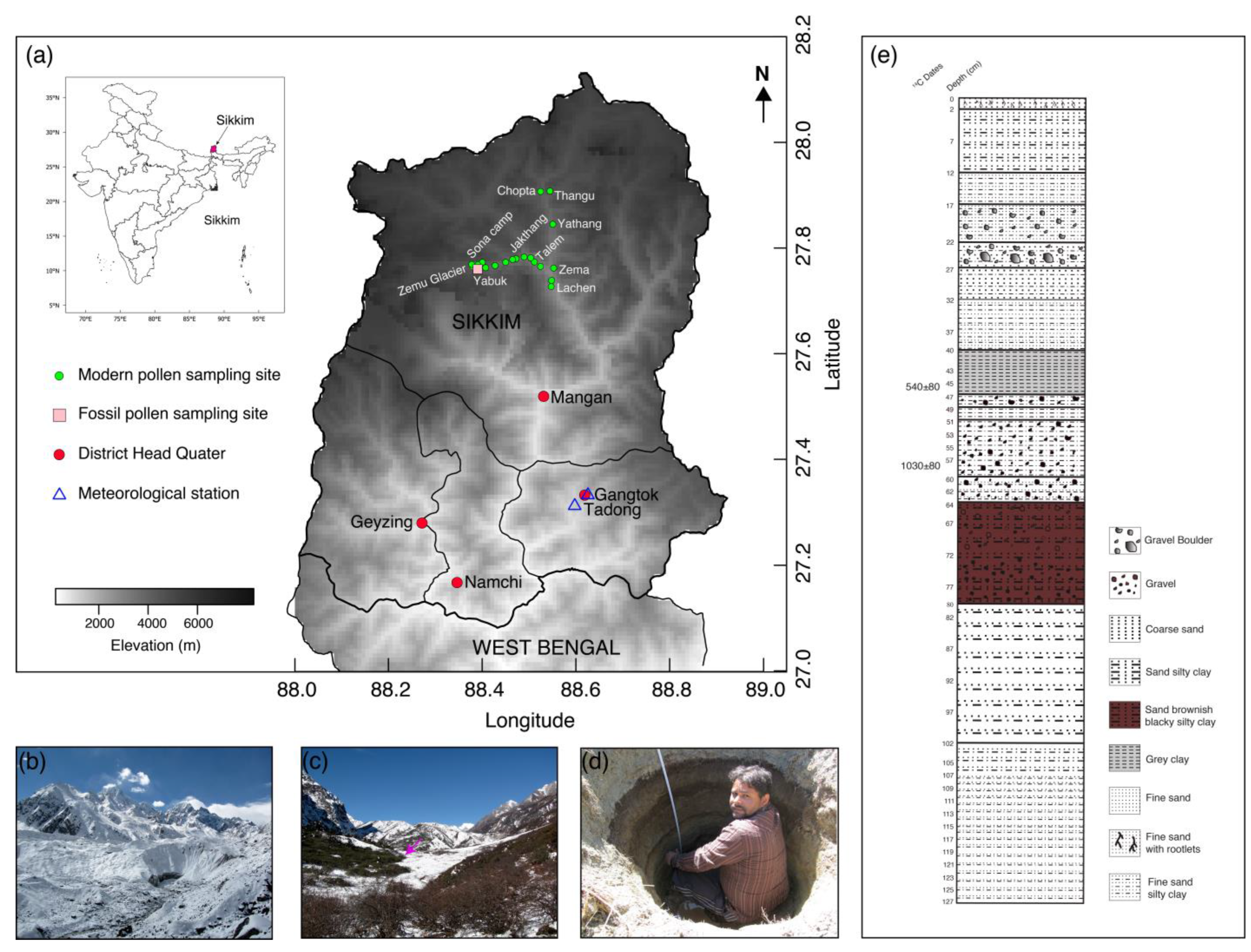

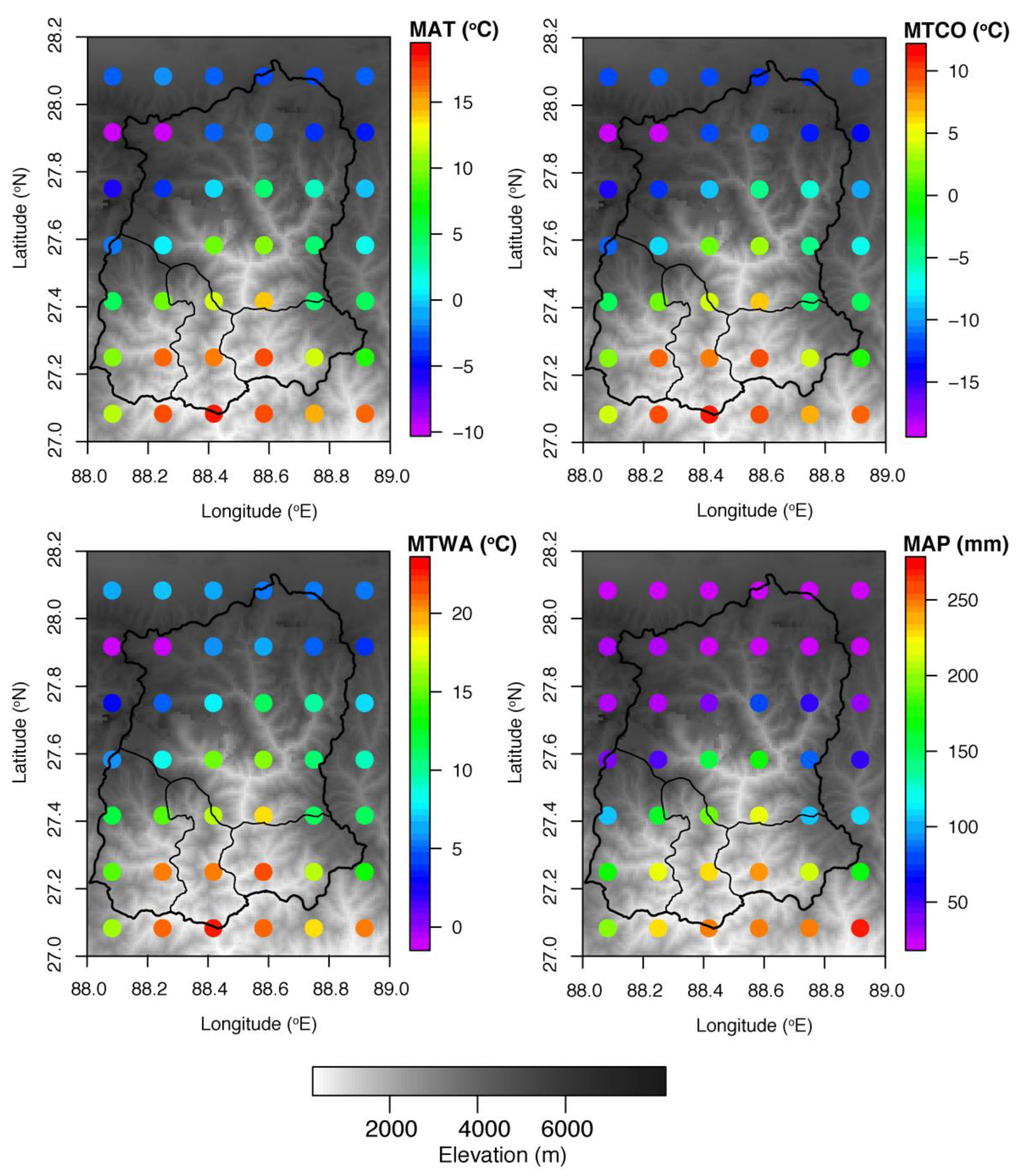

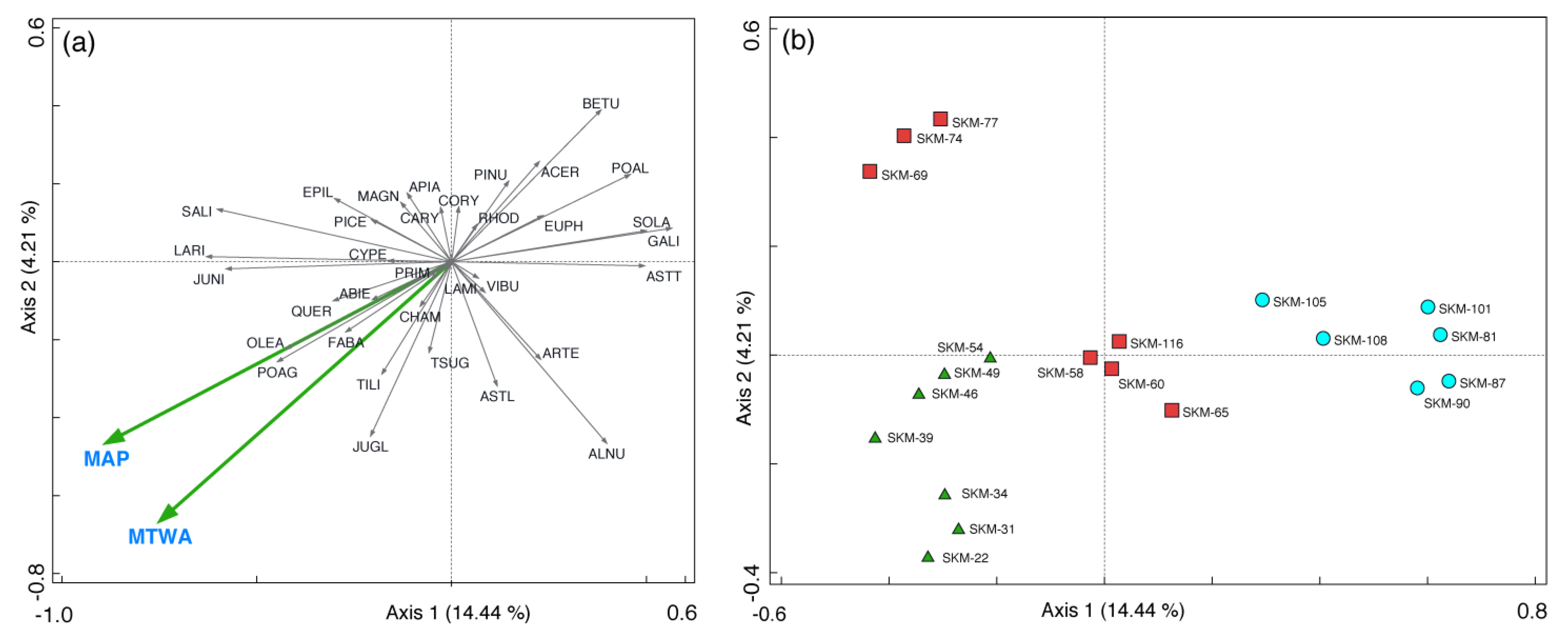

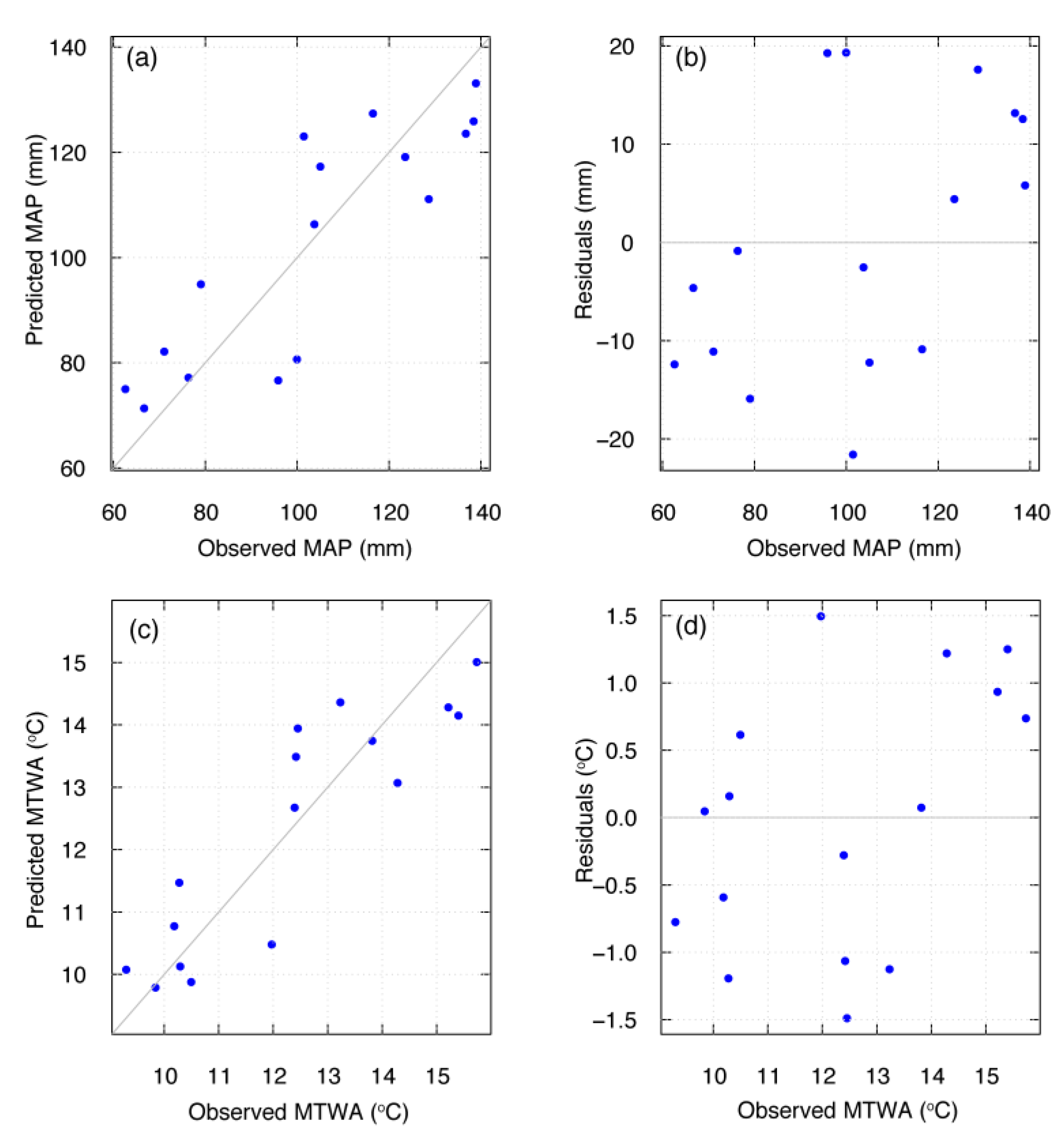
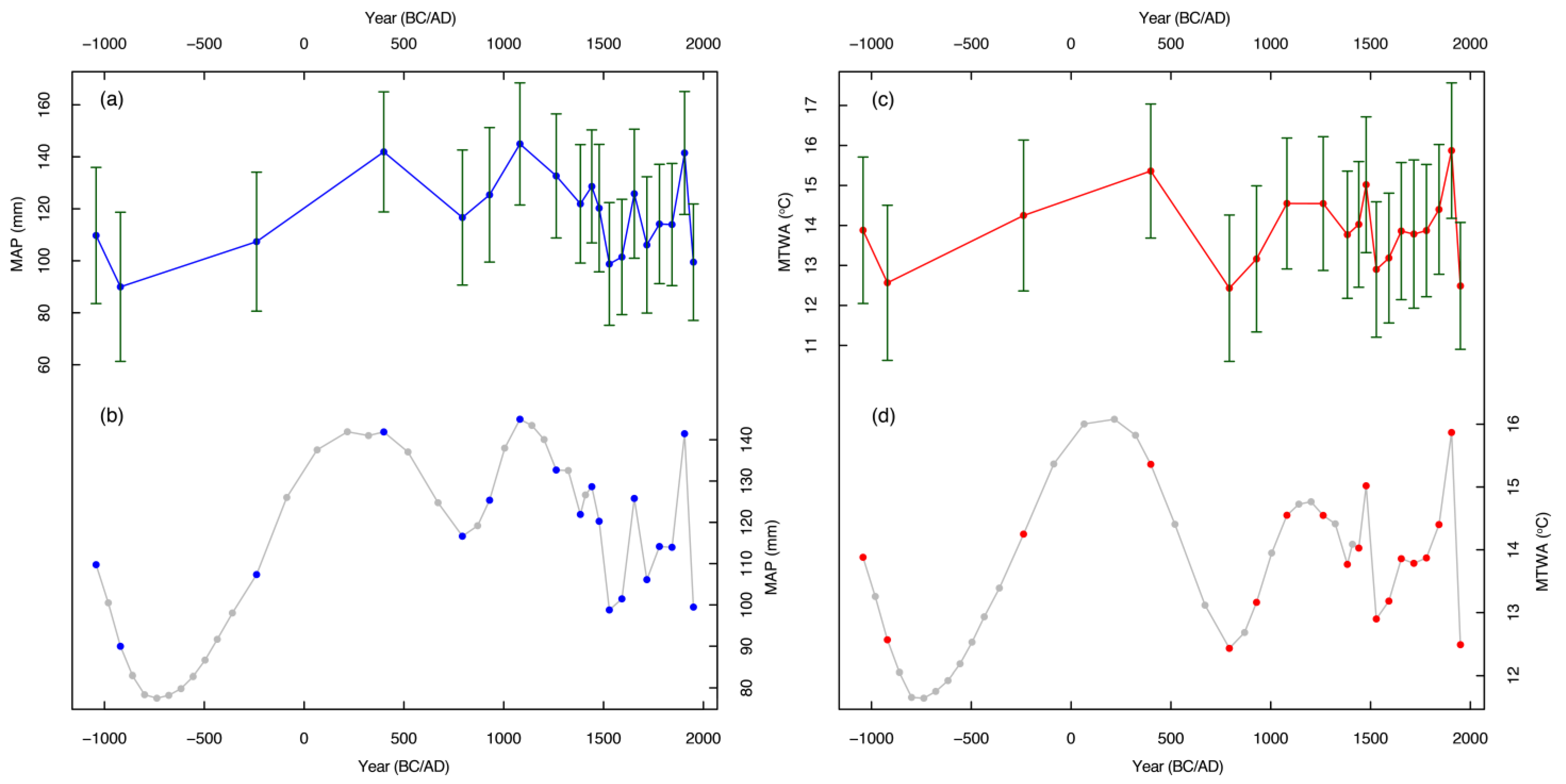
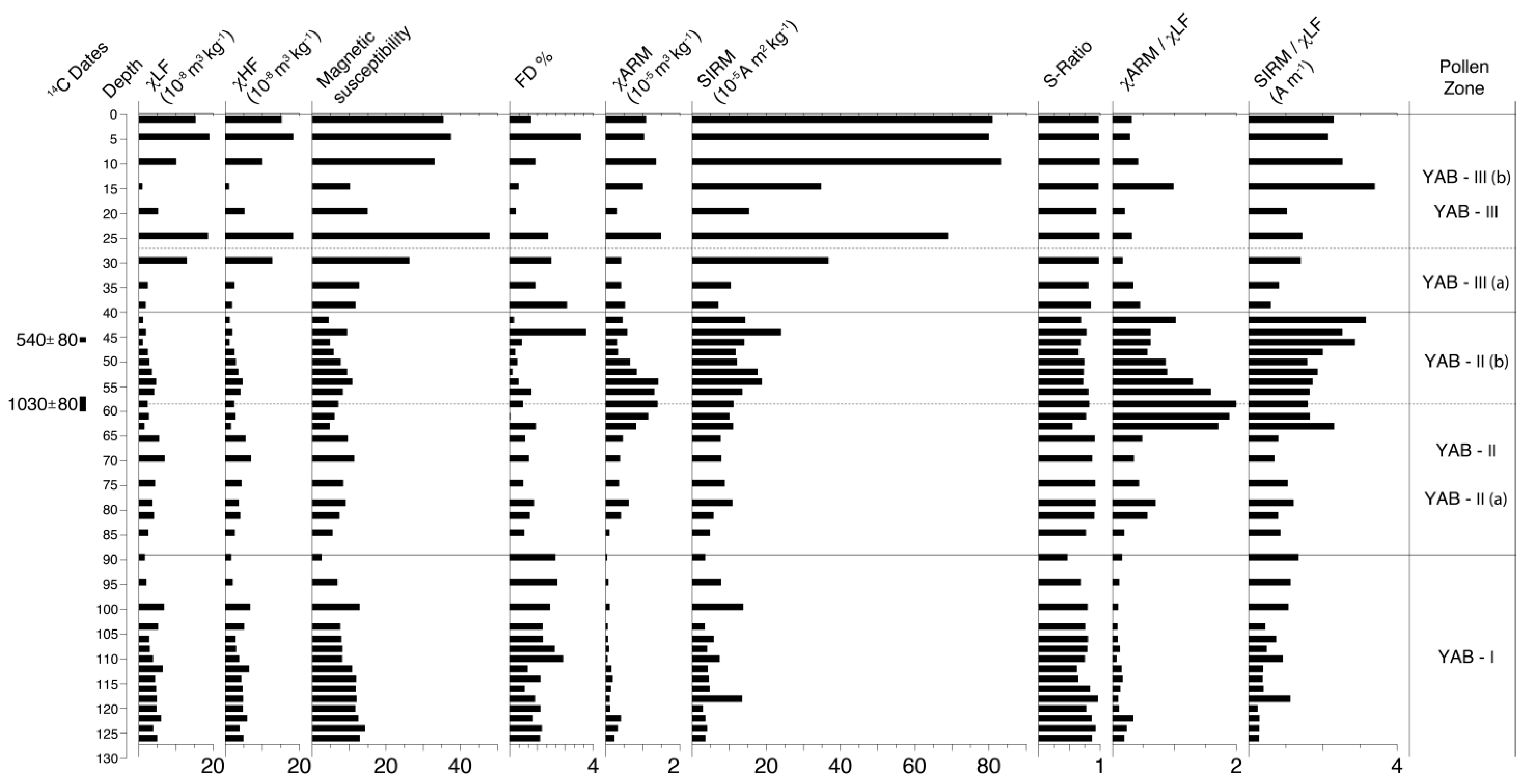
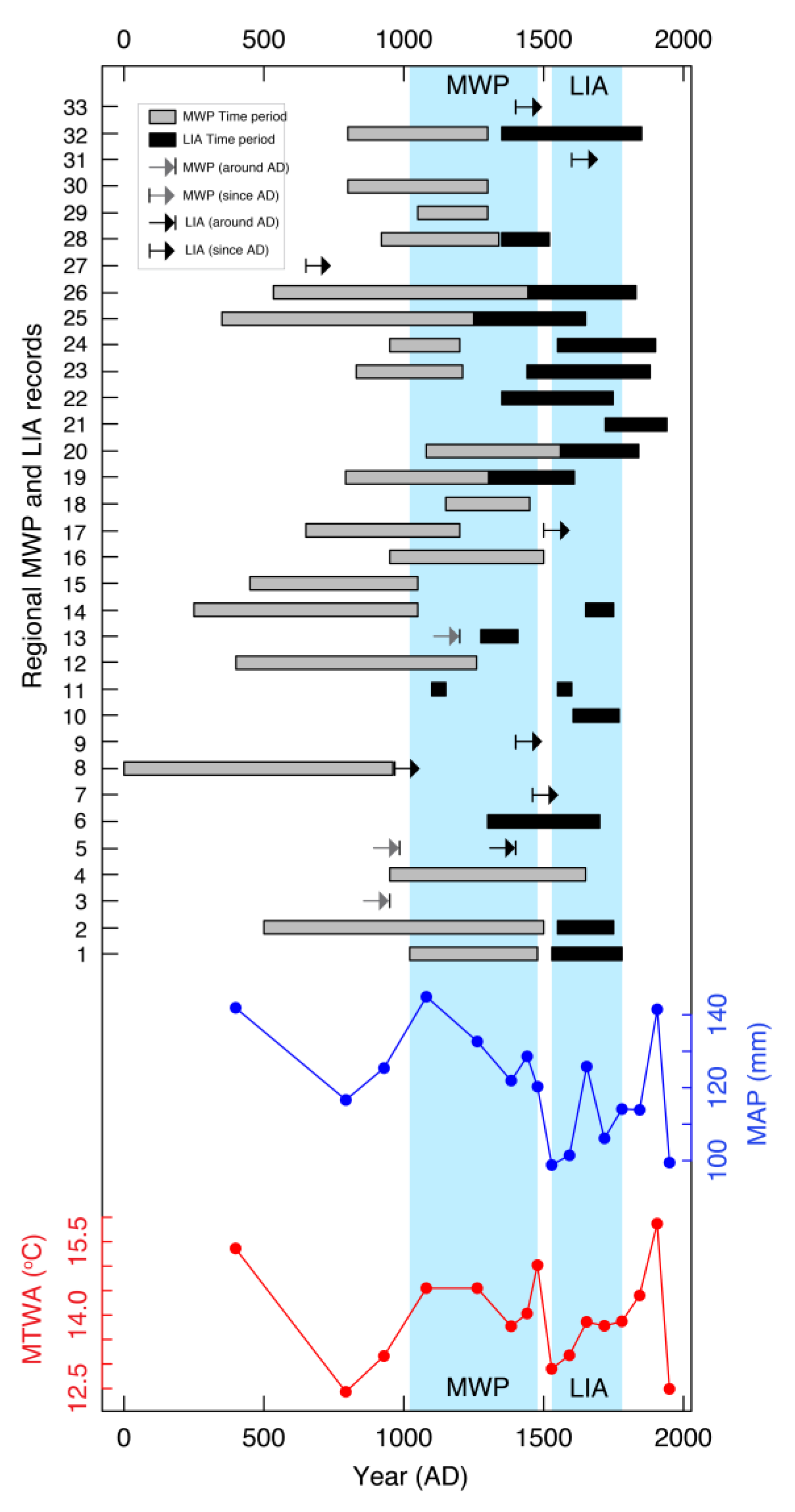
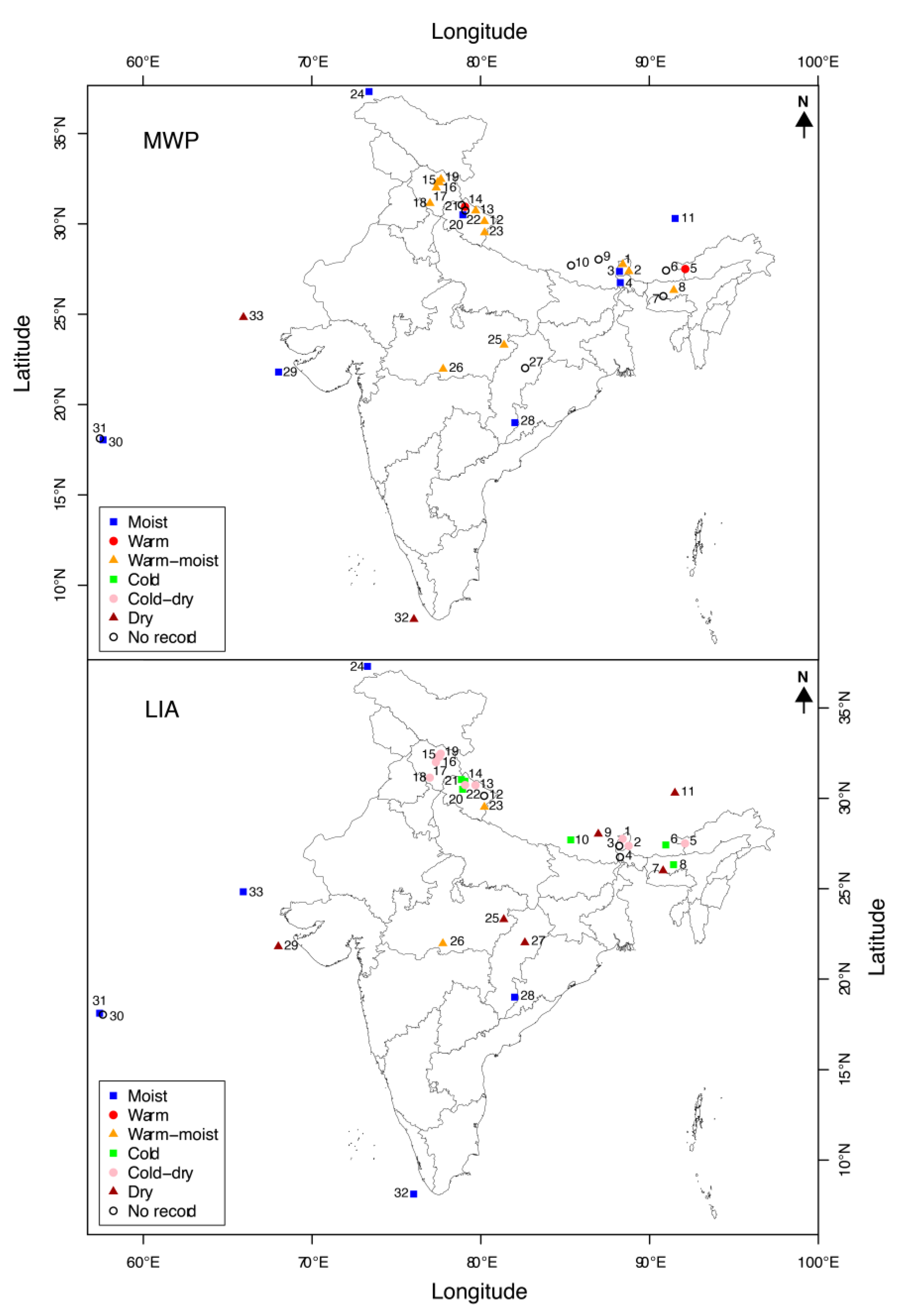

| YABUK 12 | YABUK 18 | |
|---|---|---|
| Depth (cm) | 46 | 58.5 |
| 14C Radiocarbon age | 540 ± 80 | 1030 ± 80 |
| Calibrated age (cal yrs BP) | 566 | 945 |
| Calendar age (BC/AD) | 1384 | 1005 |
| Apparent | Cross-Validated (Leave-One-Out) | |||
|---|---|---|---|---|
| PLS Component | RMSE | Correlation (r2) | RMSEP | Correlation (r2) |
| MAP | ||||
| Component 1 a | 19.017 | 0.479 | 23.593 | 0.235 |
| Component 2 a | 14.034 | 0.717 | 25.818 | 0.207 |
| Component 3 a | 11.679 | 0.804 | 27.380 | 0.213 |
| Component 4 a | 9.412 | 0.873 | 33.026 | 0.129 |
| Component 5 a | 7.650 | 0.916 | 36.318 | 0.116 |
| Component 6 a | 6.674 | 0.936 | 38.949 | 0.105 |
| Component 1 b | 13.061 | 0.734 | 18.501 | 0.473 |
| Component 2 b | 8.783 | 0.880 | 18.918 | 0.480 |
| Component 3 b | 5.574 | 0.952 | 18.699 | 0.505 |
| Component 4 b | 4.062 | 0.974 | 18.688 | 0.514 |
| Component 5 b | 3.558 | 0.980 | 17.103 | 0.580 |
| Component 6 b * | 2.193 | 0.993 | 17.076 | 0.585 |
| MTWA | ||||
| Component 1 a | 1.651 | 0.439 | 2.103 | 0.158 |
| Component 2 a | 1.198 | 0.705 | 2.180 | 0.176 |
| Component 3 a | 0.991 | 0.798 | 2.230 | 0.214 |
| Component 4 a | 0.794 | 0.870 | 2.641 | 0.133 |
| Component 5 a | 0.642 | 0.915 | 2.918 | 0.121 |
| Component 6 a | 0.562 | 0.935 | 3.084 | 0.109 |
| Component 1 b | 0.942 | 0.792 | 1.381 | 0.555 |
| Component 2 b | 0.604 | 0.915 | 1.309 | 0.609 |
| Component 3 b | 0.423 | 0.958 | 1.217 | 0.658 |
| Component 4 b | 0.332 | 0.974 | 1.215 | 0.663 |
| Component 5 b * | 0.279 | 0.982 | 1.154 | 0.696 |
| Component 6 b | 0.174 | 0.993 | 1.245 | 0.657 |
Disclaimer/Publisher’s Note: The statements, opinions and data contained in all publications are solely those of the individual author(s) and contributor(s) and not of MDPI and/or the editor(s). MDPI and/or the editor(s) disclaim responsibility for any injury to people or property resulting from any ideas, methods, instructions or products referred to in the content. |
© 2023 by the authors. Licensee MDPI, Basel, Switzerland. This article is an open access article distributed under the terms and conditions of the Creative Commons Attribution (CC BY) license (https://creativecommons.org/licenses/by/4.0/).
Share and Cite
Mehrotra, N.; Basavaiah, N.; Shah, S.K. Revisit the Medieval Warm Period and Little Ice Age in Proxy Records from Zemu Glacier Sediments, Eastern Himalaya: Vegetation and Climate Reconstruction. Quaternary 2023, 6, 32. https://doi.org/10.3390/quat6020032
Mehrotra N, Basavaiah N, Shah SK. Revisit the Medieval Warm Period and Little Ice Age in Proxy Records from Zemu Glacier Sediments, Eastern Himalaya: Vegetation and Climate Reconstruction. Quaternary. 2023; 6(2):32. https://doi.org/10.3390/quat6020032
Chicago/Turabian StyleMehrotra, Nivedita, Nathani Basavaiah, and Santosh K. Shah. 2023. "Revisit the Medieval Warm Period and Little Ice Age in Proxy Records from Zemu Glacier Sediments, Eastern Himalaya: Vegetation and Climate Reconstruction" Quaternary 6, no. 2: 32. https://doi.org/10.3390/quat6020032
APA StyleMehrotra, N., Basavaiah, N., & Shah, S. K. (2023). Revisit the Medieval Warm Period and Little Ice Age in Proxy Records from Zemu Glacier Sediments, Eastern Himalaya: Vegetation and Climate Reconstruction. Quaternary, 6(2), 32. https://doi.org/10.3390/quat6020032






